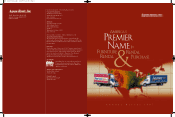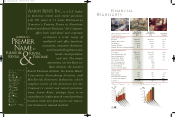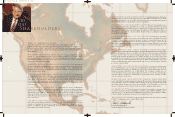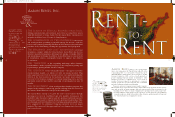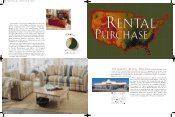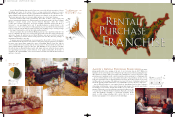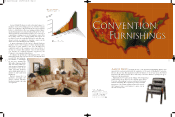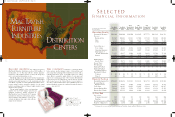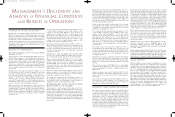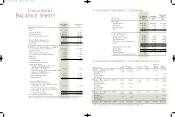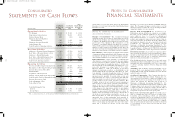Aarons 1997 Annual Report Download - page 11
Download and view the complete annual report
Please find page 11 of the 1997 Aarons annual report below. You can navigate through the pages in the report by either clicking on the pages listed below, or by using the keyword search tool below to find specific information within the annual report.
At December 31, 1997 and 1996, and for the Years Ended
December 31, 1997 and 1996, and the Nine Months Ended
December 31, 1995.
Note A: Summary of Significant
Accounting Policies
Principles of Consolidation —The consolidated financial
statements include the accounts of Aaron Rents, Inc. and its
wholly-owned subsidiary, Aaron Investment Company (the
Company). All significant intercompany accounts and trans-
actions have been eliminated. The preparation of the
Company’s consolidated financial statements in conformity
with generally accepted accounting principles requires man-
agement to make estimates and assumptions that affect the
amounts reported in these financial statements and accompa-
nying notes. Actual results could differ from those estimates.
Line of Business—The Company is engaged in the business
of renting and selling residential and office furniture and other
merchandise throughout the U.S. The Company manufac-
tures furniture principally for its rental and sales operations.
Rental Merchandise consists primarily of residential and
office furniture, consumer electronics and other merchandise
and is recorded at cost. Prior to January 1, 1996, depreciation
was provided using the straight-line method over the esti-
mated useful life of the merchandise, principally from 1 to 5
years, after allowing for a salvage value of 5% to 60%.
Effective January 1, 1996, the Company prospectively
changed its depreciation method on merchandise in the
rental purchase division acquired after December 31, 1995,
from generally 14 months straight-line with a 5% salvage
value to a method that depreciates the merchandise over the
agreement period, generally 12 months, when on rent, and
36 months, when not on rent, to a 0% salvage value. This new
method is similar to a method referred to as the income fore-
casting method in the rental purchase industry. The
Company adopted the new method because management
believes that it provides a more systematic and rational allo-
cation of the cost of rental purchase merchandise over its
useful life. The effect for the year ended December 31, 1996
of the change in the depreciation method on merchandise
purchased after December 31, 1995 was to decrease net
income by approximately $850,000 ($.04 per share). In
addition, based on an analysis of the average composite life of
the division’s rental purchase merchandise on rent or on
hand at December 31, 1995, the Company extended the
depreciable lives of that merchandise from generally 14
months to 18 months, and made other refinements to depre-
ciation rates on rental and rental purchase merchandise. The
effect of such change in depreciable lives and other refine-
ments was to increase net income for the year ended
December 31, 1996 by approximately $709,000 ($.04 per
share). The Company recognizes rental revenues over the
rental period and recognizes all costs of servicing and main-
taining merchandise on rent as incurred.
Property, Plant and Equipment are recorded at cost.
Depreciation and amortization are computed on a straight-
line basis over the estimated useful lives of the respective
assets, which are from 8 to 27 years for buildings and
improvements and from 2 to 5 years for other depreciable
property and equipment. Gains and losses related to disposi-
tions and retirements are included in income. Maintenance
and repairs are charged to income as incurred; renewals and
betterments are capitalized. The Company adopted
Statement of Financial Accounting Standards No. 121,
“Accounting for the Impairment of Long-Lived Assets and for
Long-Lived Assets to be Disposed Of”(SFAS 121), in the first
quarter of 1996. The effect of the adoption was not material.
Deferred Income Taxes are provided for temporary differ-
ences between the amounts of assets and liabilities for finan-
cial and tax reporting purposes. Such temporary differences
arise principally from the use of accelerated depreciation
methods on rental merchandise for tax purposes.
Cost of Sales includes the depreciated cost of rental return
residential and office merchandise sold and the cost of new
residential and office merchandise sold. It is not practicable
to allocate operating expenses between selling and rental
operations.
Advertising—The Company expenses advertising costs as
incurred. Such costs aggregated $9,530,000 in 1997,
$10,422,000 in 1996, and $6,258,000 for the nine months
ended December 31, 1995.
Stock Based Compensation —The Company has elected to
follow Accounting Principles Board Opinion No. 25,
“Accounting for Stock Issued to Employees”(APB 25) and
related Interpretations in accounting for its employee stock
options and adopted the disclosure-only provisions of
Statement of Financial Accounting Standards No. 123,
“Accounting for Stock Based Compensation”(FAS 123). The
Company grants stock options for a fixed number of shares
to employees with an exercise price equal to the fair value of
the shares at the date of grant and, accordingly, recognizes no
compensation expense for the stock option grants.
Excess Costs over Net Assets Acquired —Goodwill is amor-
tized on a straight-line basis over a period of twenty years.
Long-lived assets, including goodwill, are periodically
reviewed for impairment based on an assessment of future
operations. The Company records impairment losses on long-
lived assets used in operations when indicators of impair-
ment are present and the undiscounted cash flows estimated
to be generated by those assets are less than the assets’
carrying amount.
19
Notes to Consolidated
Financial Statements
Nine
Year Ended Year Ended Months Ended
December 31, December 31, December 31,
(In Thousands) 1997 1996 1995
Operating Activities
Net Earnings $ 18,396 $ 15,393 $ 9,880
Depreciation & Amortization 77,487 70,693 45,798
Deferred Income Taxes 3,805 (899) (345)
Change in Accounts Payable &
Accrued Expenses 5,103 5,695 242
Change in Accounts Receivable (1,083) (2,339) 255
Other Changes, Net 1,587 982 (711)
Cash Provided by Operating Activities 105,295 89,525 55,119
Investing Activities
Additions to Property, Plant & Equipment (15,165) (17,534) (5,476)
Book Value of Property Retired or Sold 6,531 1,823 1,979
Additions to Rental Merchandise (145,262) (137,023) (72,926)
Book Value of Rental Merchandise Sold 58,436 48,352 30,892
Contracts & O ther Assets Acquired (21,665) (3,891) (533)
Cash Used by Investing Activities (117,125) (108,273) (46,064)
Financing Activities
Proceeds from Revolving Credit Agreement 118,545 85,299 51,933
Repayments on Revolving Credit Agreement (97,766) (67,434) (56,845)
Increase (Decrease) in Other Debt 342 21 (768)
Dividends Paid (761) (765) (367)
Acquisition of Treasury Stock (8,918) (2,889) (3,134)
Issuance of Stock Under Stock Option Plan 400 4,502 129
Cash Provided (Used) by Financing Activities 11,842 18,734 (9,052)
Increase (Decrease) in Cash 12 (14) 3
Cash at Beginning of Year 84 98 95
Cash at End of Year $ 96 $ 84 $ 98
Cash Paid During the Year:
Interest $ 3,713 $ 3,384 $ 2,642
Income Taxes 6,989 7,531 7,677
The accompanying notes are an integral part of the Consolidated Financial Statements.
18
Consolidated
Statements of Cash Flows
AR layout Final.wpc 4/24/98 8:24 AM Page 21

